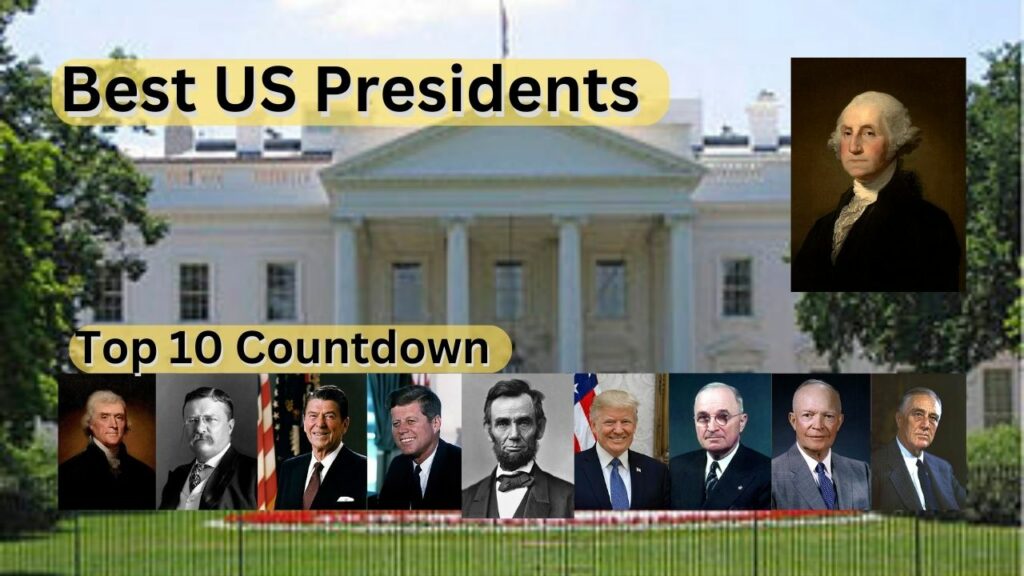
Criteria for the list of best U.S. presidents
This Top 10 countdown list of best U.S. presidents is constructed based on a specific set of criteria aimed at assessing their historical significance with an emphasis on factors such as economic policies, foreign relations, policy achievements, executive leadership, and political impact. The goal is to provide a nuanced perspective that reflects the diverse aspects of presidential performance while considering the overarching theme of unity within the nation.
Economic policies play a pivotal role in shaping this evaluation. Presidents who have demonstrated a positive impact on job creation, GDP growth, and economic stability are given due consideration. Donald Trump, for instance, is recognized for his emphasis on economic policies such as tax reform and deregulation, which some argue contributed to economic growth during his tenure. The inclusion of Ronald Reagan also aligns with this criterion, given his well-known economic policies, commonly referred to as “Reaganomics,” and his efforts to stimulate the economy.
Foreign policy is another crucial aspect influencing the rankings. Presidents who have effectively navigated international relations, managed trade agreements, and contributed to global stability are acknowledged. Franklin D. Roosevelt’s leadership during World War II is a prime example, highlighting the significance of effective foreign policy in times of global crisis. Similarly, Donald Trump’s approach to international relations is considered, recognizing the impact of his administration on diplomatic engagements and trade relationships.
Policy achievements, encompassing a range of issues from healthcare to immigration, form an integral part of the assessment. The ability to implement and achieve key policy goals is crucial in understanding a president’s impact on the nation. Abraham Lincoln’s historic efforts to preserve the Union and end slavery exemplify the profound influence of policy achievements on shaping the course of the country.
Executive leadership, emphasizing a president’s ability to lead the executive branch effectively and make decisive decisions, is a fundamental criterion. George Washington, as the first president, is acknowledged for his role in establishing the foundations of the nation and providing essential leadership during its formative years. This leadership quality is also considered in the evaluation of other presidents, such as Dwight D. Eisenhower.
Political impact is the final criterion, focusing on a president’s ability to navigate the political landscape, build coalitions, and achieve legislative successes. In this context, the list acknowledges the political acumen of figures like Ronald Reagan and Donald Trump, who have left a lasting impact on the nation’s political landscape.
The consideration of these criteria aims to offer a comprehensive and balanced assessment of each president’s contributions, ensuring that the list reflects diverse perspectives on their historical significance with a specific emphasis on unity within the United States.
The Top 10 List of best U.S. presidents in summary
- George Washington (1789-1797): “Father of His Country” – As the first president, Washington played a crucial role in unifying the newly formed United States.
- Donald Trump (2017-2021): “The Donald” or “Orange Man” – Emphasizing policies that supporters argue contributed to economic growth and focusing on aspects that resonate with a significant portion of the population.
- Abraham Lincoln (1861-1865): “Honest Abe” or “The Great Emancipator” – Lincoln’s leadership during the Civil War and his efforts to preserve the Union, even at the cost of tremendous national strife, highlight his commitment to unity.
- Franklin D. Roosevelt (1933-1945): “FDR” – FDR’s presidency during the Great Depression and World War II, with an emphasis on his ability to rally the nation, remains significant.
- Ronald Reagan (1981-1989): “The Great Communicator” – Reagan’s appeal to conservative values and efforts to bring about economic recovery could still place him prominently.
- Dwight D. Eisenhower (1953-1961): “Ike” – Eisenhower’s focus on unity and his warning against the military-industrial complex contribute to his historical standing.
- John F. Kennedy (1961-1963): “JFK” – Kennedy’s inspirational leadership and calls for unity during the Cold War era are noteworthy.
- Thomas Jefferson (1801-1809): “Man of the People” or “Author of Independence” – Despite ideological differences, Jefferson’s contributions to the nation’s early development and the Louisiana Purchase are recognized.
- Harry S. Truman (1945-1953): “Give ‘Em Hell Harry” – Truman’s decisions during the post-war period, including the Marshall Plan, can be considered in the context of fostering stability.
- Theodore Roosevelt (1901-1909): – “Teddy” or “The Rough Rider” Roosevelt’s Progressive Era reforms and efforts to address societal issues may be acknowledged.
10. Theodore Roosevelt (1858-1919)
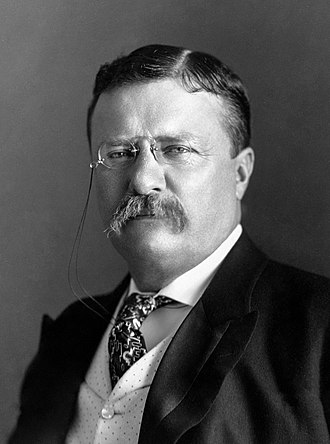
Born on October 27, 1858, in New York City, Theodore Roosevelt, a Republican, served as the 26th President of the United States from 1901 to 1909. He passed away on January 6, 1919. Roosevelt’s biggest achievement was the Progressive Era reforms and the establishment of the national parks system.
Here are the top ten accomplishments of Theodore Roosevelt:
- Trust-Busting: Roosevelt’s commitment to trust-busting aimed to curb the power of large corporations and promote fair competition. The antitrust actions he initiated, including the dissolution of the Northern Securities Company and the prosecution of Standard Oil, had a lasting impact on the business landscape. This not only addressed economic inequality but also paved the way for a more competitive marketplace.
- Conservation: Roosevelt’s emphasis on conservation transformed the nation’s approach to natural resources. Through executive orders and legislation, he expanded the national parks system, creating five national parks, 18 national monuments, and initiating the establishment of the United States Forest Service. This legacy had profound environmental and recreational implications, shaping the nation’s commitment to preserving its natural heritage.
- Consumer Protection: Roosevelt’s advocacy for consumer protection led to landmark legislation, including the Pure Food and Drug Act and the Meat Inspection Act. These measures aimed to ensure the safety of food and pharmaceuticals, addressing public health concerns. The long-term effect was the establishment of regulatory frameworks that continue to protect consumers today, laying the groundwork for modern food and drug safety standards.
- Diplomacy and Nobel Peace Prize: Roosevelt’s role in negotiating the end of the Russo-Japanese War showcased his diplomatic prowess. The Treaty of Portsmouth, negotiated in 1905, earned him the Nobel Peace Prize. This diplomatic success not only brought an end to a major conflict but also positioned the United States as a key player on the world stage.
- Panama Canal: Roosevelt’s commitment to the construction of the Panama Canal had far-reaching implications for global trade and military strategy. The canal, completed in 1914, facilitated maritime travel between the Atlantic and Pacific Oceans, significantly reducing the time and cost of transportation. This strategic infrastructure project bolstered U.S. influence in the Western Hemisphere and beyond.
- Square Deal: The Square Deal, Roosevelt’s domestic policy agenda, aimed to strike a balance between labor, business, and the public. This approach addressed issues related to workers’ rights, corporate power, and consumer safety. The Square Deal laid the foundation for future progressive reforms and underscored Roosevelt’s commitment to social and economic justice.
- Great White Fleet: Sending the Great White Fleet on a world tour from 1907 to 1909 was a demonstration of U.S. naval power. This not only showcased American strength but also served diplomatic purposes, fostering goodwill and reinforcing strategic alliances. The fleet’s voyage underscored the United States’ emergence as a global naval force.
- Pure Food and Drug Act: Enacted in 1906, the Pure Food and Drug Act marked a significant step in consumer protection. It aimed to eliminate adulterated and misbranded food and drugs, addressing public concerns about the safety and purity of products. This legislation set the stage for the modern regulatory framework overseeing the safety of the food and pharmaceutical industries.
- Newlands Reclamation Act: The Newlands Reclamation Act, signed into law in 1902, supported the development of irrigation projects in the arid West. By providing federal assistance for water resource management, the act promoted agricultural sustainability in regions where water scarcity posed a significant challenge. This had lasting effects on the expansion of agriculture in these areas.
- National Reclamation Act: Also known as the Newlands Act, this legislation was instrumental in supporting water resource management and irrigation in the western United States. By providing federal funding for irrigation projects, the act aimed to make arid lands more suitable for cultivation, contributing to the agricultural development of the region. This had long-term implications for the economic viability and settlement patterns in the West.
Conclusion:
Theodore Roosevelt’s inclusion in this list is justified by his multifaceted impact on American society. His trust-busting efforts, commitment to conservation, advocacy for consumer protection, diplomatic successes, and infrastructure projects like the Panama Canal shaped the nation’s trajectory in the early 20th century. The Square Deal and the Great White Fleet further solidified Roosevelt’s legacy, demonstrating his comprehensive approach to governance and his role in positioning the United States as a major player on the global stage.
9. Harry S. Truman (1884-1972)
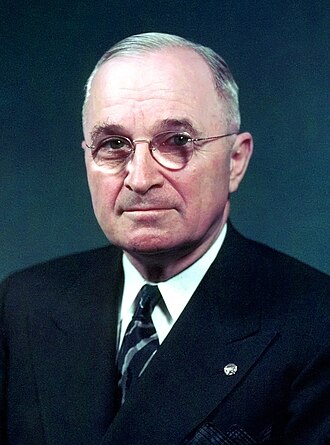
Born on May 8, 1884, in Lamar, Missouri, Harry S. Truman, a Democrat, served as the 33rd President of the United States from 1945 to 1953. He passed away on December 26, 1972. Truman’s biggest achievement was his leadership during the post-World War II period, including the decision to drop atomic bombs and the initiation of the Marshall Plan.
Here are the top ten accomplishments of Harry S. Truman:
- Decision to Drop Atomic Bombs: Perhaps Truman’s most controversial and consequential decision was ordering the dropping of atomic bombs on Hiroshima and Nagasaki in 1945. This decision, while hastening the end of World War II, had profound and enduring moral, ethical, and geopolitical implications. It reshaped the global order, marking the beginning of the nuclear age and influencing Cold War dynamics.
- Marshall Plan: Truman’s initiation of the Marshall Plan in 1948 was a pivotal moment in post-war reconstruction. The plan provided economic assistance to Western European nations devastated by World War II, preventing the spread of communism and fostering stability. Its long-term impact included the economic recovery of Europe and the consolidation of U.S. influence in the region.
- Formation of the United Nations: Truman played a key role in the establishment of the United Nations in 1945. This international organization aimed to promote cooperation and prevent future global conflicts. Truman’s vision for the United Nations reflected a commitment to collective security and diplomacy on the world stage.
- NATO: Truman supported the formation of the North Atlantic Treaty Organization (NATO) in 1949. This military alliance was created to counter the threat of Soviet expansion in Europe during the early years of the Cold War. NATO continues to play a central role in European security and transatlantic relations.
- Integration of the Armed Forces: Truman’s issuance of an executive order in 1948 to desegregate the U.S. military marked a significant step towards racial integration in the country. This move was a precursor to later civil rights advancements and contributed to the ongoing struggle for equality.
- Berlin Airlift: In response to the Soviet blockade of West Berlin in 1948, Truman organized the Berlin Airlift. This humanitarian effort supplied the city with essential goods, showcasing American commitment to its allies and demonstrating the resolve to resist Soviet pressures during the early stages of the Cold War.
- Fair Deal: Truman’s Fair Deal, a series of progressive reforms proposed in the post-war era, faced challenges in Congress. Though not fully realized, the Fair Deal included civil rights initiatives, national health insurance proposals, and education funding. It set the stage for future discussions on social and economic policy.
- Recognition of Israel: Truman’s swift recognition of the State of Israel shortly after its declaration of independence in 1948 demonstrated U.S. support for the newly established nation. This decision had significant implications for Middle Eastern geopolitics and contributed to the formation of diplomatic relations between the United States and Israel.
- Taft-Hartley Act: In 1947, Truman vetoed the Taft-Hartley Act, which sought to restrict the power of labor unions. Despite his veto, Congress overrode it, and the act became law. Truman’s resistance reflected his commitment to workers’ rights, but the act had enduring effects on labor-management relations in the United States.
- Desegregation of Federal Workforce: Truman’s executive order in 1948 to desegregate the federal workforce marked a pivotal moment in the broader civil rights movement. This action set the precedent for subsequent measures aimed at dismantling racial segregation in government institutions.
Conclusion:
Harry S. Truman’s presidency was characterized by momentous decisions and actions that shaped the post-World War II world. From the atomic bomb to the Marshall Plan, Truman’s initiatives played a crucial role in defining the early years of the Cold War and establishing the United States as a global leader. His commitment to desegregation and civil rights, as well as his efforts to promote international cooperation through organizations like the United Nations and NATO, contribute to his lasting impact on U.S. and world history. Truman’s leadership during a critical period of transition and tension solidifies his place in the top 10 U.S. presidents.
8. Thomas Jefferson (1743-1826)
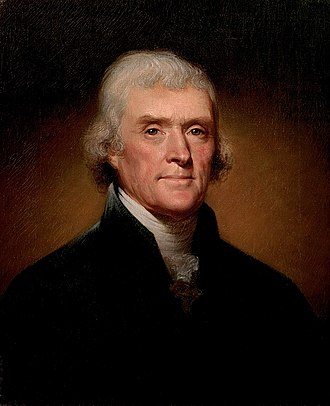
Born on April 13, 1743, in Shadwell, Virginia, Thomas Jefferson, a Democratic-Republican, served as the 3rd President of the United States from 1801 to 1809. He passed away on July 4, 1826. Jefferson’s biggest achievement was the acquisition of the Louisiana Territory, effectively doubling the size of the United States.
Here are the top ten accomplishments of Thomas Jefferson:
- Louisiana Purchase: One of the most significant moments in Jefferson’s presidency was the acquisition of the vast Louisiana Territory from France in 1803. This historic land deal, negotiated by James Monroe and Robert Livingston, doubled the size of the United States and opened up vast expanses of territory for westward expansion. The long-term effects of the Louisiana Purchase shaped the nation’s geography, resources, and opportunities for settlement.
- Declaration of Independence: While not an accomplishment during his presidency, Jefferson’s role as the principal author of the Declaration of Independence in 1776 is a foundational contribution to the nation’s history. The document eloquently articulated the ideals of individual rights, equality, and self-government, becoming a touchstone for American democracy.
- Lewis and Clark Expedition: Jefferson commissioned the Lewis and Clark Expedition in 1804 to explore the newly acquired Louisiana Territory and map a route to the Pacific Ocean. Led by Meriwether Lewis and William Clark, the expedition provided valuable information about the geography, flora, and fauna of the West, contributing to future settlement and scientific understanding.
- Embargo Act of 1807: Jefferson’s implementation of the Embargo Act in 1807 aimed to protect American interests by restricting trade, particularly with Britain and France during their conflicts. However, the act had severe economic consequences and faced significant opposition. While it ultimately failed in its immediate objectives, it highlighted the challenges of maintaining neutrality in a global context.
- Establishment of West Point: Jefferson signed legislation in 1802 establishing the United States Military Academy at West Point, New York. This institution played a crucial role in training military officers and has had a lasting impact on the nation’s defense and leadership.
- Barbary Wars: Jefferson, faced with challenges from North African states demanding tribute for safe passage of American ships, initiated the First Barbary War in 1801. This conflict asserted U.S. naval power and established the principle of not paying tribute to pirates. The subsequent Treaty of Tripoli in 1805 marked the end of tribute payments.
- Reduction of Military Spending: Jefferson, committed to limited government and reducing federal expenditures, significantly reduced military spending during his presidency. This approach reflected his belief in a smaller government and fiscal responsibility.
- Louisiana Territory Exploration: Beyond the Louisiana Purchase, Jefferson’s emphasis on exploration and scientific inquiry in the West laid the groundwork for future understanding of the continent. His support for the Lewis and Clark Expedition and other exploration initiatives contributed to the nation’s knowledge of its vast and diverse geography.
- 1807 Slave Trade Act: Jefferson signed the Act Prohibiting Importation of Slaves in 1807, which banned the international slave trade. While it did not end slavery in the United States, it reflected a recognition of the moral and political issues associated with the trade of enslaved people.
- Founding of the University of Virginia: Jefferson’s vision for public education included the founding of the University of Virginia in 1819. The university, designed to advance the principles of religious freedom and intellectual inquiry, remains an enduring institution of higher education.
Conclusion:
Thomas Jefferson’s presidency is marked by both historic achievements and challenges. The Louisiana Purchase, his contributions to the Declaration of Independence, and the Lewis and Clark Expedition are central to his legacy. Jefferson’s vision of westward expansion, exploration, and commitment to education reflect his multifaceted impact on the development of the United States. While his presidency faced difficulties, such as the Embargo Act, Jefferson’s enduring contributions to American democracy and the nation’s territorial and educational expansion earn him a place among the top U.S. presidents.
7. John F. Kennedy (1917-1963)
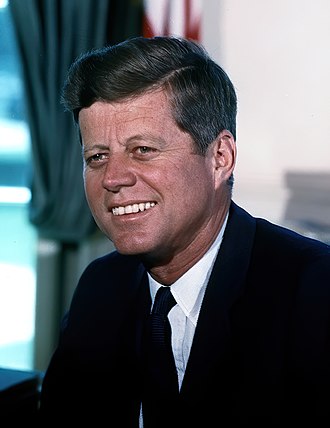
Born on May 29, 1917, in Brookline, Massachusetts, John F. Kennedy, a Democrat, served as the 35th President of the United States from 1961 until his assassination on November 22, 1963. Kennedy’s presidency is often remembered for its youthful vigor, the Cuban Missile Crisis, and advancements in the civil rights movement.
Here are the top ten accomplishments of John F. Kennedy:
- Cuban Missile Crisis: Kennedy’s handling of the Cuban Missile Crisis in 1962 is considered one of his most significant achievements. Faced with the presence of Soviet nuclear missiles in Cuba, Kennedy’s measured response and negotiations with Soviet Premier Nikita Khrushchev averted a potential nuclear conflict. This crisis showcased Kennedy’s leadership under intense pressure and contributed to a thaw in U.S.-Soviet relations.
- Establishment of the Peace Corps: Kennedy’s vision for international cooperation led to the establishment of the Peace Corps in 1961. The program aimed to promote global peace and friendship by sending American volunteers to work on projects in developing countries. The Peace Corps has since become a symbol of American humanitarian efforts worldwide.
- Space Race and the Moon Landing: Kennedy set an ambitious goal in 1961 to land an American on the moon before the end of the decade. The Apollo program, inspired by this vision, achieved success with the Apollo 11 mission in 1969, making the United States the first nation to land humans on the lunar surface. Kennedy’s commitment to space exploration had lasting effects on scientific achievement and national pride.
- Berlin Wall Speech: In 1963, Kennedy delivered his famous “Ich bin ein Berliner” speech in West Berlin, expressing solidarity with the citizens of West Berlin and opposing the construction of the Berlin Wall by the Soviet Union. This speech affirmed the United States’ commitment to the defense of democratic values and remains a symbol of the Cold War struggle for freedom.
- Nuclear Test Ban Treaty: Kennedy played a pivotal role in negotiating the Limited Test Ban Treaty in 1963, which prohibited nuclear weapons testing in the atmosphere, outer space, and underwater. This treaty marked a step towards nuclear arms control and environmental protection.
- Alliance for Progress: Launched in 1961, the Alliance for Progress was a program aimed at promoting economic development and social reform in Latin America. While its impact varied, the alliance demonstrated Kennedy’s commitment to fostering positive relations and addressing economic disparities in the Western Hemisphere.
- Bay of Pigs Invasion: The Bay of Pigs Invasion in 1961, although ultimately a failure, showcased Kennedy’s willingness to take responsibility for decisions. The invasion aimed to overthrow Fidel Castro’s regime in Cuba but ended in embarrassment for the U.S. Kennedy’s handling of the aftermath increased his caution in subsequent Cold War crises.
- Civil Rights Commitment: Kennedy, despite initial caution, eventually became a vocal supporter of the civil rights movement. He proposed comprehensive civil rights legislation, which was later passed as the Civil Rights Act of 1964. While Kennedy did not live to see its passage, his advocacy contributed to the landmark legislation.
- New Frontier: Kennedy’s domestic agenda, known as the New Frontier, included proposals to stimulate economic growth, improve education, and advance civil rights. Although some initiatives faced challenges in Congress, the New Frontier represented a commitment to progressive change.
- Consumer Bill of Rights: Kennedy presented a Consumer Bill of Rights to Congress in 1962, outlining principles for consumer protection. While not enacted during his presidency, this initiative contributed to later legislation and efforts to ensure fair treatment and information for consumers.
Conclusion:
John F. Kennedy’s presidency was marked by both moments of triumph and challenges. His leadership during the Cuban Missile Crisis, commitment to space exploration, and efforts in advancing civil rights are central to his legacy. While the Bay of Pigs Invasion highlighted the complexities of Cold War strategies, Kennedy’s vision for international cooperation, particularly in the space race and nuclear arms control, had a lasting impact on the nation’s trajectory. His untimely death in 1963 elevated him to an iconic figure in American history.
6. Dwight D. Eisenhower (1890-1969)
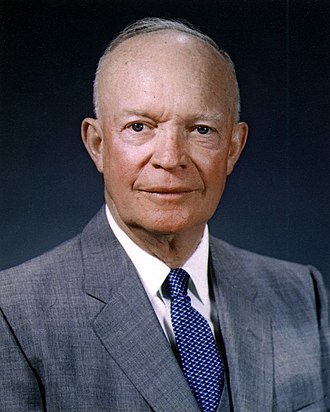
Born on October 14, 1890, in Denison, Texas, Dwight D. Eisenhower, a Republican, served as the 34th President of the United States from 1953 to 1961. Eisenhower’s presidency is characterized by his leadership during World War II and his focus on domestic infrastructure projects during peacetime.
Here are the top ten accomplishments of Dwight D. Eisenhower:
- Leadership during World War II: As the Supreme Commander of the Allied Expeditionary Forces during World War II, Eisenhower played a crucial role in the planning and execution of the D-Day invasion in 1944. His leadership contributed to the defeat of Nazi Germany and the liberation of Western Europe.
- Interstate Highway System: Eisenhower championed the establishment of the Interstate Highway System, signing the Federal-Aid Highway Act of 1956. This ambitious infrastructure project aimed to create a network of high-speed highways, enhancing transportation, facilitating economic growth, and bolstering national defense by providing efficient routes for military transport.
- Domino Theory and Containment: Eisenhower’s foreign policy was shaped by the Domino Theory, which asserted that the spread of communism in one country could lead to the fall of neighboring nations like a row of falling dominos. This ideology influenced the policy of containment, focusing on preventing the spread of communism, and had a lasting impact on U.S. Cold War strategies.
- Nuclear Deterrence and “Eisenhower Doctrine”: Eisenhower embraced the concept of nuclear deterrence, emphasizing the importance of a strong nuclear arsenal to prevent the outbreak of a major conflict. The “Eisenhower Doctrine” articulated the U.S. commitment to provide economic and military assistance to Middle Eastern countries resisting communist aggression, aligning with his broader containment policy.
- Desegregation of Schools: Eisenhower faced the challenging issue of racial desegregation in schools, particularly highlighted by the landmark case Brown v. Board of Education. While progress was gradual, Eisenhower took steps to enforce desegregation, sending federal troops to Little Rock, Arkansas, in 1957 to ensure the integration of Central High School.
- Brinksmanship and the Cold War: Eisenhower’s approach to the Cold War was characterized by “brinksmanship,” a strategy of pushing the conflict to the brink of war to compel the Soviet Union to back down. This approach aimed to avoid direct military conflict while demonstrating American resolve.
- NASA and the Space Race: Eisenhower established the National Aeronautics and Space Administration (NASA) in 1958 in response to the Soviet Union’s successful launch of Sputnik. This marked the beginning of the Space Race, with the United States striving to achieve significant milestones, including putting the first man on the moon.
- Federal Aid to Education: Eisenhower signed the National Defense Education Act in 1958, providing federal funding to improve education in science, mathematics, and foreign languages. This legislation aimed to address concerns about American technological and educational competitiveness during the Cold War.
- Farewell Address: In his farewell address in 1961, Eisenhower warned against the growing influence of the “military-industrial complex,” expressing concern about the potential undue influence of the military and defense industries on national policy. This cautionary message remains influential in discussions about the relationship between the military and civilian sectors.
- Alaska and Hawaii Statehood: Eisenhower presided over the admission of Alaska and Hawaii as the 49th and 50th states, respectively, in 1959. This expansion of the Union marked a significant chapter in American history, reflecting the nation’s growth and diversity.
Conclusion:
Dwight D. Eisenhower’s presidency is characterized by his leadership during World War II, the pursuit of infrastructure projects like the Interstate Highway System, and the implementation of policies that shaped U.S. Cold War strategies. His focus on nuclear deterrence, commitment to space exploration, and efforts to address issues of racial segregation and education underscore the complexity of his tenure. Eisenhower’s farewell address remains a poignant reminder of the challenges and responsibilities associated with military and industrial power. Overall, his presidency left a lasting impact on the nation’s infrastructure, defense strategies, and education policies.
5. Ronald Reagan (1911-2004)
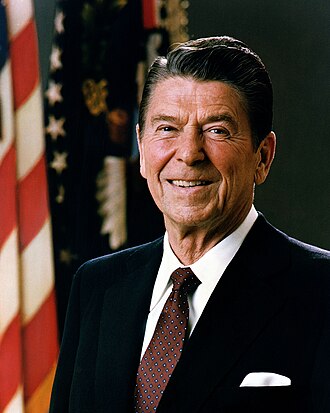
Born on February 6, 1911, in Tampico, Illinois, Ronald Reagan, a Republican, served as the 40th President of the United States from 1981 to 1989. Reagan’s presidency is often associated with conservative economic policies, a strong stance against communism, and efforts to reshape the role of government.
Here are the top ten accomplishments of Ronald Reagan:
- Economic Policies – Reaganomics: Reagan implemented a series of economic policies collectively known as Reaganomics. This included tax cuts, reduced government regulations, and supply-side economic measures aimed at stimulating economic growth. The policies are credited by supporters with contributing to a period of sustained economic expansion during the 1980s.
- End of the Cold War: Reagan’s administration played a significant role in the end of the Cold War. His strong anti-communist stance, combined with diplomatic efforts and military buildups, contributed to the Soviet Union’s weakening. The thawing of relations between the U.S. and the Soviet Union ultimately led to the end of the Cold War and the dissolution of the Soviet Union.
- Strategic Defense Initiative (SDI): Reagan proposed the Strategic Defense Initiative in 1983, a missile defense system designed to protect the United States from potential nuclear attacks. While SDI faced criticism and technical challenges, its announcement influenced arms reduction negotiations and showcased Reagan’s commitment to national defense.
- Recovery from Economic Recession: When Reagan took office, the U.S. was facing a severe economic recession. His administration implemented policies to curb inflation, reduce unemployment, and spur economic growth. The economy rebounded, leading to a period of sustained expansion known as the “Reagan Recovery.”
- Conservative Social Policies: Reagan’s presidency was marked by conservative social policies, including his stance against abortion and support for traditional family values. His administration supported efforts to restrict abortion access and advocated for “family values” as part of the conservative agenda.
- Air Traffic Controllers’ Strike: In 1981, Reagan took a strong stance against the Professional Air Traffic Controllers Organization (PATCO) strike, firing more than 11,000 striking air traffic controllers. This move sent a message about his commitment to maintaining order and discipline in the face of labor unrest.
- Tax Reform Act of 1986: Reagan signed the Tax Reform Act of 1986, a comprehensive tax reform that simplified the tax code, reduced tax rates, and broadened the tax base. The legislation had a significant impact on the U.S. tax system, influencing subsequent discussions on tax policy.
- Iran-Contra Affair: The Reagan administration faced controversy with the Iran-Contra Affair, involving the secret sale of arms to Iran and the use of proceeds to fund Contra rebels in Nicaragua. While Reagan was not directly implicated, the scandal raised questions about the administration’s transparency and adherence to the law.
- Nomination of Sandra Day O’Connor: Reagan nominated Sandra Day O’Connor to the Supreme Court in 1981, making her the first woman to serve on the highest court in the United States. This historic nomination contributed to the diversification of the Supreme Court.
- Reagan’s Communication Skills: Reagan was known for his exceptional communication skills, often referred to as the “Great Communicator.” His ability to connect with the American people through speeches and televised addresses contributed to his popularity and effectiveness as a leader.
Conclusion:
Ronald Reagan’s presidency is characterized by a mix of economic policies, a strong anti-communist stance, and conservative social values. The impact of Reaganomics, the end of the Cold War, and his approach to national defense are among the defining aspects of his tenure. While facing challenges such as the Iran-Contra Affair, Reagan’s leadership style and communication skills left an enduring mark on American politics. His legacy as a transformative figure in conservative politics and international relations contributes to his recognition as one of the top U.S. presidents.
4. Franklin D. Roosevelt (1882-1945)
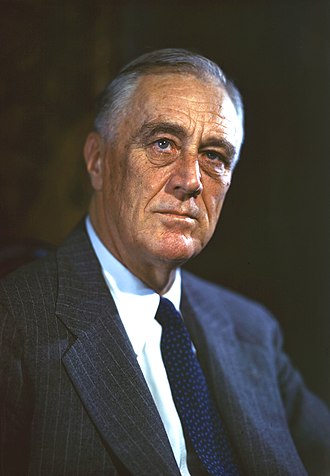
Born on January 30, 1882, in Hyde Park, New York, Franklin D. Roosevelt, a Democrat, served as the 32nd President of the United States from 1933 until his death in 1945. FDR’s presidency was defined by his response to the Great Depression, the New Deal, and leadership during World War II.
Here are the top ten accomplishments of Franklin D. Roosevelt:
- New Deal Programs: FDR’s New Deal was a series of programs and policies implemented in response to the Great Depression. The New Deal aimed to provide relief, recovery, and reform, addressing economic challenges through initiatives such as the Civilian Conservation Corps (CCC), Works Progress Administration (WPA), and Social Security Act. These programs had a profound impact on the nation’s recovery and laid the groundwork for modern social and economic policies.
- Banking and Financial Reforms: Faced with a banking crisis upon taking office in 1933, FDR swiftly implemented measures to stabilize the banking system. The Emergency Banking Act and the Glass-Steagall Act were key components of his strategy, providing a foundation for financial stability and regulatory frameworks.
- Social Security Act: Enacted in 1935, the Social Security Act established a system of social insurance, providing financial assistance to retirees, the unemployed, and disabled individuals. Social Security remains a cornerstone of the U.S. social safety net, offering economic security to millions of Americans.
- Establishment of the Securities and Exchange Commission (SEC): To address issues of financial fraud and restore confidence in the stock market, FDR signed the Securities Act of 1933 and the Securities Exchange Act of 1934. These laws led to the creation of the Securities and Exchange Commission (SEC), overseeing securities transactions and enforcing regulations.
- Good Neighbor Policy: FDR’s Good Neighbor Policy aimed to improve relations with Latin American countries, emphasizing non-intervention and cooperation. This shift in diplomatic approach contributed to stronger ties between the United States and its neighbors in the Western Hemisphere.
- Lend-Lease Act: FDR championed the Lend-Lease Act in 1941, providing military aid to Allied nations during World War II before direct U.S. involvement. This significant policy marked a shift toward greater support for Allied forces and strengthened the United States’ role in the global conflict.
- Four Freedoms Speech: In his 1941 State of the Union address, FDR articulated the Four Freedoms—freedom of speech, freedom of worship, freedom from want, and freedom from fear. These principles became a rallying cry for the Allied cause and a foundation for post-war international ideals.
- Executive Order 9066: FDR signed Executive Order 9066 in 1942, leading to the internment of Japanese Americans during World War II. While this decision remains controversial and has been widely criticized, it reflects the complexities of wartime leadership.
- Wartime Leadership: FDR’s leadership during World War II was crucial, guiding the nation through the early years of conflict and shaping the Allied strategy. His coordination with Allied leaders, including Winston Churchill and Joseph Stalin, played a key role in the ultimate defeat of Axis powers.
- Founding of the United Nations: FDR played a pivotal role in the establishment of the United Nations (UN). His vision for a post-war international organization aimed at promoting peace and cooperation became a reality with the signing of the United Nations Charter in 1945, laying the groundwork for the UN’s subsequent role in global affairs.
Conclusion:
Franklin D. Roosevelt’s presidency is marked by its transformative impact on the nation during a period of unprecedented challenges. The New Deal, social and financial reforms, and FDR’s leadership during World War II significantly shaped the course of American history. Despite controversies, such as the internment of Japanese Americans, Roosevelt’s legacy is enduring, with many of his policies continuing to influence domestic and international affairs. FDR’s leadership during times of crisis and his innovative approach to governance solidify his place as one of the most consequential U.S. presidents.
3. Abraham Lincoln (1809-1865)
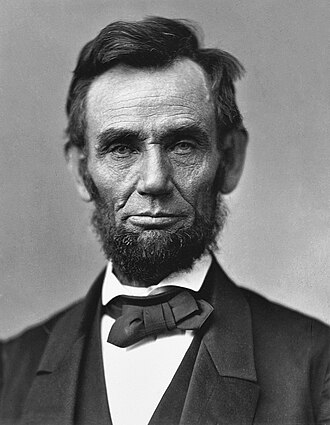
Born on February 12, 1809, in Hardin County, Kentucky, Abraham Lincoln, a Republican, served as the 16th President of the United States from 1861 until his assassination in 1865. Lincoln’s presidency was defined by the Civil War, the preservation of the Union, and the abolition of slavery.
Here are the top ten accomplishments of Abraham Lincoln:
- Emancipation Proclamation: One of Lincoln’s most consequential acts was the Emancipation Proclamation, issued in 1863 during the Civil War. This executive order declared that all slaves in Confederate-held territory were to be set free. While it didn’t immediately free all enslaved individuals, it changed the character of the war, making abolition a central goal and inspiring many to join the Union cause.
- Gettysburg Address: Lincoln delivered the Gettysburg Address in 1863, a short but powerful speech that emphasized the principles of equality and democracy. Given at the dedication of the Soldiers’ National Cemetery in Gettysburg, Pennsylvania, the address is considered one of the greatest speeches in American history.
- Preservation of the Union: Lincoln’s leadership during the Civil War was focused on preserving the Union. He navigated the country through its bloodiest conflict, making difficult strategic and political decisions to ensure the survival of the United States as a single nation.
- Homestead Act of 1862: Lincoln signed the Homestead Act into law in 1862, providing 160 acres of public land to settlers for a small fee, provided they improve the land by building a dwelling and cultivating crops. This legislation encouraged westward expansion and played a significant role in the development of the American frontier.
- Pacific Railway Act: Lincoln signed the Pacific Railway Act in 1862, promoting the construction of the First Transcontinental Railroad. This infrastructure project connected the East and West coasts, facilitating transportation and commerce across the continent.
- Establishment of the National Banking System: In 1863, Lincoln signed the National Banking Act, creating a system of national banks and a single national currency. This laid the foundation for a more stable and organized financial system in the United States.
- Moral Leadership and Compassion: Lincoln’s moral leadership and compassion were evident in his efforts to heal the nation’s wounds. His willingness to forgive and reconcile with the Southern states after the Civil War contributed to the process of national healing.
- Suspension of Habeas Corpus: During the Civil War, Lincoln controversially suspended the writ of habeas corpus, allowing for the arrest and detention of individuals without a trial. While criticized for infringing on civil liberties, Lincoln argued that these measures were necessary to preserve the Union.
- Creation of the Department of Agriculture: Lincoln established the Department of Agriculture in 1862, recognizing the importance of promoting and regulating agricultural practices. This marked a significant step toward addressing the needs of the nation’s farmers.
- Thirteenth Amendment: Lincoln played a crucial role in the passage of the Thirteenth Amendment to the Constitution in 1865. This amendment abolished slavery in the United States, fulfilling a key promise of the Emancipation Proclamation and marking a transformative moment in American history.
Conclusion:
Abraham Lincoln’s presidency is indelibly linked to the challenges of the Civil War and the quest for a more perfect union. His leadership during a tumultuous period, the Emancipation Proclamation, and the preservation of the Union are enduring aspects of his legacy. Lincoln’s commitment to principles of equality, moral leadership, and the pursuit of a more united nation solidify his place as one of the greatest U.S. presidents in history.
2. Donald J. Trump (1946-present)
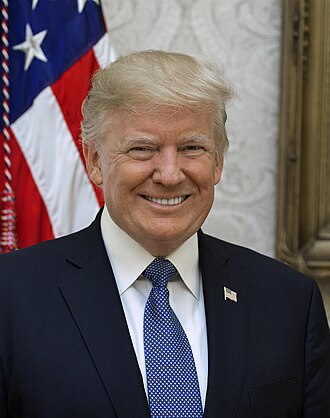
Born on June 14, 1946, in Queens, New York, Donald J. Trump, a Republican, served as the 45th President of the United States from January 20, 2017, to January 20, 2021. Trump’s presidency was marked by a populist agenda, economic policies, and a distinctive approach to both domestic and foreign affairs.
Here are the top ten accomplishments of Donald J. Trump:
- Tax Cuts and Jobs Act: One of Trump’s significant legislative accomplishments was the Tax Cuts and Jobs Act of 2017. This tax reform bill aimed to stimulate economic growth by reducing corporate and individual tax rates, simplifying the tax code, and encouraging investment. Proponents argued that it contributed to economic expansion and job creation.
- Criminal Justice Reform: Trump signed the First Step Act into law in 2018, a bipartisan criminal justice reform bill aimed at reducing recidivism and improving prison conditions. The legislation received support for its efforts to address issues such as mandatory minimum sentences and promote rehabilitation.
- Deregulation: Trump pursued an aggressive deregulation agenda, aiming to reduce bureaucratic hurdles for businesses. Through executive actions and agency directives, his administration rolled back numerous regulations, arguing that it would spur economic growth and innovation.
- Historic Middle East Peace Agreements: The Trump administration brokered a series of diplomatic agreements between Israel and Arab nations, including the Abraham Accords. These agreements marked a historic shift in Middle East dynamics and were aimed at fostering peace and normalization of relations in the region.
- Operation Warp Speed: In response to the COVID-19 pandemic, Trump’s administration launched Operation Warp Speed, an initiative to accelerate the development, production, and distribution of COVID-19 vaccines. The program played a crucial role in facilitating the rapid deployment of vaccines in the United States.
- Appointment of Federal Judges: Trump made a lasting impact on the federal judiciary by appointing three Supreme Court justices and numerous federal judges. This effort aimed to reshape the judicial branch with conservative-leaning judges, influencing the interpretation of laws for years to come.
- Trade Policies: Trump pursued a renegotiation of trade agreements, including the United States-Mexico-Canada Agreement (USMCA) as a replacement for NAFTA. His administration also engaged in trade negotiations with China, implementing tariffs as part of efforts to address perceived trade imbalances.
- Diplomacy with North Korea: Trump engaged in unprecedented diplomacy with North Korea, meeting with North Korean leader Kim Jong-un in summits aimed at addressing nuclear weapons and fostering improved relations. While the outcomes were mixed, the meetings represented a shift in diplomatic approach.
- Border Security and Immigration Policies: Trump made border security and immigration key priorities, advocating for enhanced border controls and stricter immigration policies. This included efforts to build a border wall and implement policies aimed at addressing illegal immigration.
- COVID-19 Response and Operation Warp Speed: Trump’s administration initiated Operation Warp Speed, a public-private partnership to accelerate the development, production, and distribution of COVID-19 vaccines. While the response faced criticism, the rapid development and distribution of vaccines contributed to efforts to control the pandemic.
Conclusion:
Donald Trump’s presidency was marked by a mix of policy achievements and controversies. His economic policies, judicial appointments, and diplomatic initiatives in the Middle East left a lasting impact. However, his leadership style, approach to divisive issues, and handling of the COVID-19 pandemic were sources of significant debate and criticism. The evaluation of Trump’s presidency is complex, reflecting a divided public opinion on his legacy and the impact of his policies on the nation.
1. George Washington (1732-1799)
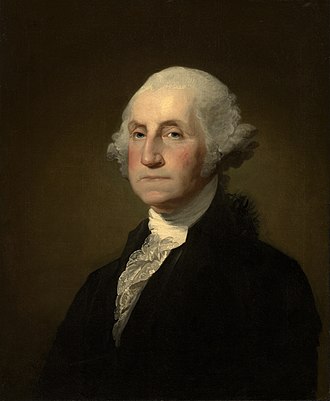
Born on February 22, 1732, in Westmoreland County, Virginia, George Washington served as the first President of the United States from April 30, 1789, to March 4, 1797. As the leader of the Continental Army during the American Revolution and the nation’s inaugural president, Washington’s contributions were foundational to the establishment and stability of the United States.
Here are the top ten accomplishments of George Washington:
- Commander-in-Chief of the Continental Army: Washington played a pivotal role in the American Revolutionary War, serving as the commander-in-chief of the Continental Army. His leadership during the war, marked by perseverance, strategic acumen, and personal bravery, was instrumental in achieving American independence.
- Presiding Officer of the Constitutional Convention: Washington presided over the Constitutional Convention in Philadelphia in 1787, where the United States Constitution was drafted. His presence lent credibility to the proceedings, and his support for the new Constitution helped ensure its ratification.
- Unanimous Election as President: Washington was unanimously elected as the first President of the United States in 1788 and 1792. His widespread popularity and the respect he commanded from various factions demonstrated the trust placed in him to guide the fledgling nation.
- Establishment of Presidential Precedents: As the first president, Washington set crucial precedents for the office. He defined the role of the presidency, established the cabinet system, and initiated traditions such as the two-term limit. His decisions shaped the office’s nature and the balance of powers within the government.
- Farewell Address: In his Farewell Address in 1796, Washington provided guidance for the nation’s future. He emphasized the importance of national unity, warned against the dangers of political parties and foreign entanglements, and advocated for a policy of neutrality in foreign affairs.
- Whiskey Rebellion: Washington’s response to the Whiskey Rebellion in 1794 demonstrated the federal government’s ability to enforce its authority. By personally leading a militia force to quell the rebellion against a federal excise tax on whiskey, he reinforced the principle of federal supremacy.
- Judiciary Act of 1789: Washington signed the Judiciary Act of 1789 into law, establishing the federal court system. This legislation played a crucial role in shaping the judiciary’s structure and function and remains a foundational component of the federal legal system.
- Signing of the Bill of Rights: Washington signed the Bill of Rights into law in 1791, addressing concerns about individual liberties and the potential abuse of federal power. The first ten amendments to the Constitution, the Bill of Rights ensured essential rights and protections for American citizens.
- Neutrality Proclamation: In 1793, Washington issued the Neutrality Proclamation, declaring the United States’ neutrality in the conflict between France and Great Britain. This diplomatic move helped to avoid entanglement in European conflicts and safeguarded the nation’s interests.
- Founding Father and Symbol of the Nation: Washington’s role as a Founding Father and symbol of the nation’s unity was crucial. His leadership during the Revolution, commitment to a strong and stable federal government, and voluntary relinquishment of power after two terms set a precedent for future leaders and cemented his legacy as the “Father of His Country.”
Conclusion:
George Washington’s impact on the United States is immeasurable. From leading the Continental Army to guiding the Constitutional Convention and serving as the first President, Washington’s leadership laid the foundation for the nation’s success. His commitment to principles of democracy, national unity, and the rule of law continues to shape the character of the United States, making him an enduring figure in American history and the top U.S. president.
This concludes our Top 10 countdown of best US Presidents. I hope you enjoyed this list.
